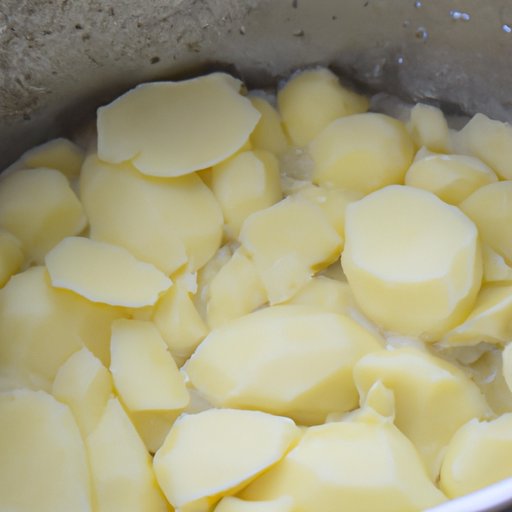
I. Introduction
Whether you are a seasoned cook or just starting to learn how to make mashed potatoes, knowing how to boil potatoes properly is crucial. Perfectly boiled potatoes are the foundation of great mashed potatoes that are creamy, fluffy, and delicious. This article will provide a step-by-step guide to boiling potatoes for mashed potatoes, explore the science behind it, share some stories and history about mashed potatoes, discuss the impact of different potato varieties, offer recipes for different styles, and suggest some perfect pairings to complete your dish.
II. A Step-by-Step Guide
Before you start boiling potatoes, make sure you have these ingredients: potatoes (2-3 per person), salt (about 1 tsp of salt for every 4 cups of water), and butter or milk for mashing. It is important to choose the right type of potato for mashed potatoes. Russet potatoes are the most commonly used type for their high starch content, which makes them fluffy and light. Yukon gold potatoes are also a great option as they are very creamy, but they are less fluffy than russet potatoes.
Start by peeling the potatoes and cutting them into equal-sized pieces so they cook evenly. Then, place them in a large pot and add enough cold water to cover them, leaving about 2 inches of water above the potatoes. Add salt and bring to a boil over high heat. Reduce the heat to medium and simmer until the potatoes are tender when pierced with a fork (usually around 15-20 minutes). Be careful not to overcook them, as this can cause them to become mushy and waterlogged.
To test if the potatoes are done, you can use a fork or a knife to poke them gently. If they are ready, the fork or knife should easily go through the potato without any resistance. Once the potatoes are done, drain them well in a colander and let them sit for a few minutes to cool down and dry off. This will ensure that they don’t absorb too much liquid when you add the butter or milk for mashing.
When it comes to mashing the potatoes, it is important to use the right tools. A potato masher works well for most people, but if you want a smoother texture, a potato ricer is also a good option. Avoid using a food processor or blender, as they can make the potatoes gluey and dense. Add in butter or milk until you reach your desired texture and flavor. Season with salt and pepper to taste.
III. The Science behind Boiling Potatoes
When potatoes are boiled, they start to absorb water, which causes the cell walls to break down and the potatoes to become cooked. The heat also causes the starch in the potatoes to absorb water and swell up, which gives them their fluffy texture. This process is called gelatinization and it is key in making great mashed potatoes. Understanding the science behind boiling potatoes will help you achieve the perfect texture every time you make them.
IV. Stories behind Mashed Potatoes
Mashed potatoes have a long and rich history that dates back centuries. The dish is considered a comfort food in many cultures and is often associated with emotional connections. In the United States, mashed potatoes are a staple side dish during Thanksgiving and Christmas, while in the United Kingdom, they are often paired with roast beef or bangers and mash. The stories and history behind mashed potatoes are fascinating and can add more meaning to your cooking experience.
V. The Impact of Different Potatoes
Not all potatoes are created equal, and the type of potato you use can greatly impact the final result of your mashed potatoes. Besides russet and Yukon gold, there are many other varieties of potatoes to choose from, such as red, purple, and fingerling. Each variety has its own unique texture and flavor, which can make a significant difference in the taste of your dish. Experimenting with different potato varieties can help you find your perfect mashed potato recipe.
VI. Recipes for Different Styles
Mashed potatoes can be made in a variety of styles, from classic and simple to more elaborate and flavorful. You can add fresh herbs, garlic, cheese, bacon, or even roasted vegetables to create a unique and delicious mash. Here are some recipes to get you started:
- Classic mashed potatoes with butter and milk
- Garlic mashed potatoes with roasted garlic and Parmesan cheese
- Loaded mashed potatoes with bacon, cheddar cheese, and green onions
- Mashed sweet potatoes with maple syrup and cinnamon
Don’t be afraid to experiment and try new flavor combinations to find your perfect mashed potato recipe. Using high-quality ingredients is key to achieving a delicious mash.
VII. The Perfect Side Dish
Mashed potatoes are a versatile side dish that pairs well with many other dishes. They can be served with grilled chicken, steak, meatloaf, or roasted vegetables. You can also use them as a base for shepherd’s pie or add them to breakfast burritos. The possibilities are endless, so get creative and find the perfect pairing for your mashed potatoes.
VIII. Conclusion
Boiling potatoes for mashed potatoes is an important step that can greatly impact the final result of your dish. By following a few simple steps and understanding the science behind it, you can achieve a creamy and fluffy mashed potato, every time. With different potato varieties, flavor combinations, and perfect pairings, mashed potatoes can be a simple yet versatile side dish that can be enjoyed by everyone.
So, give it a try and have fun experimenting with different techniques, recipes, and flavors. You might just find the perfect mashed potato recipe that will become a family tradition for years to come.




